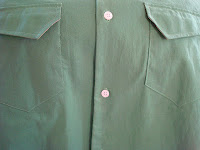The instructions on how to create the pattern pieces are very clear and quite simple. The garment is made up of three pattern pieces which are easy enough to draft. I found my 24x6 quilting ruler useful. I used squared pattern paper but as my instructions were imperial and my grid metric this was a questionable benefit. Inch square paper doesn't seem to be that easy to find in the UK anymore. A French curve might have been handy for the armholes and neck line but I made a passable free handed attempt.
One of my sister's neighbours was kind enough to send me a good sized bundle of fabric she no longer wanted. These two fabrics were included. The yellow is 100% cotton printed with a design called "Seagull" as well as gulls the motifs include starfish and sea shells. The blue deck chair stripe feels more like poly-cotton and had been hemmed as [Wendy House?] curtains in the past. I didn't have enough of either to make anything large but I thought the two designs worked well together in a seaside-y kinda way. I estimated that I would have enough fabric to piece the pinny with enough of the blue stripe left over to make the bias binding for the armholes and edging.
I elected to use the diminutive Singer 99K for this project. I hadn't touched it since I altered my ironing board cover so I thought it was owed a spin. As you will have seen from Saturday's post the designated sewing space is far too messy to use so I opted for the dinning table for this project. The 99K is also the easiest machine I have to carry over there. The blue poly-cotton is a good bit lighter than the Seagull cotton and has a tendency to pucker. I improved matters greatly by backing off the tension about three-quarters of a turn. The pattern includes a "⅜ inch turning". I guess that is 1940s speak for seam allowance. Interestingly my seam guide has a default setting for a perfect ⅜ inch seam allowance when set up as below. Was this once some kind of dressmaker's standard I wonder?
 |
| I tried my hand at directional sewing. Starting at the hem and sewing toward the waist. Did I get it right? |
Regular readers will know what a fan I am of flat felled and French seams but both of those options felt a little bit over engineered for a pinny so I decided to try a technique I had read about in a few different places on the internet. I think it was probably a post on someone else's blog, which I now can't find, which put the idea of this kind of seam finish and domestic work wear together in my head. I gather that this was a common seam finish in the days before zigzag sewing machines or over lockers. It is very simple to do you just make a line of stitching within the seam allowance. The stitches are supposed to act as a barrier to fraying. I used the ⅛ side of the presser foot, against the edge of the seam allowance as a guide for my row of stitches. On a ⅜ seam allowance this means that the ¼ inch side of the foot was against the middle of the seam. Neat or what? I love it when a plan comes together. A more upmarket looking variation on this theme, which I have yet to try, suggests turning the raw edging of the seam under and then stitching.

The only down side to using this seam finish is that you end up sewing each seam three times. The skirt of this pinny calls for no fewer than ten (yes ten!) separate panels (or should that be gores?) so I had the little 99K really chattering away to itself.
So now I have to make yards of bias binding and some apron strings. Watch this space.




































